1. Common Bed Bugs
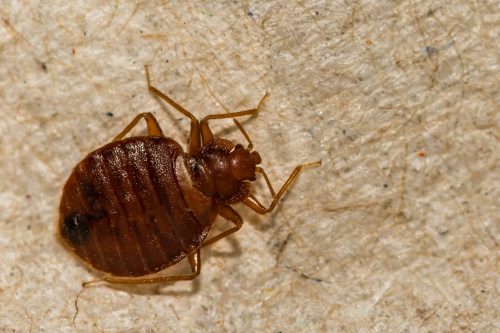
Appearance
Size
Common bed bugs are around 4-5mm or 3/16 of an inch.
They are about the size of a short grain of rice.
Color
Common bed bugs are tan or brown before eating.
After eating a blood meal they turn a reddish-brown or dark brown color.
Hair
Certain species of bed bugs are known for small hairs on their body.
The common bed bug does not have any hair on its body or head.
Antenna and Legs
The common bed bug has two long antennae.
Their antennae have four segments.
The antennae have a short thick first segment, a long moderate second segment, and third and fourth segments that are thin and get progressively shorter.
Diet
Common bed bugs require blood to survive.
Their sole source of food is blood.
The common bed bugs prefer to have a human host. Although they will resort to other pets and other mammals if no humans are available.
Habitat
Common bed bugs are most commonly found in bedrooms.
In bedrooms, they hide inside small cracks and crevices on mattresses, box springs, bed frames, folds in fabric, and other furniture near where humans sleep.
Bed bugs prefer to live near their host.
They can also infest other areas that humans frequent such as couches, carpets, and other furniture.
They can live behind baseboards in larger infestations, inside cracks on walls, picture frames, electronics, electrical switchplates, and behind wallpaper.
Distribution
Bed bugs are found in all 50 states in the U.S.
Infestations are particularly common in large cities where houses are close together.
Bed bugs are also commonly found in apartments, public transportation, schools, nursing homes, and retail stores.
According to Termix, the cities with the most bed bug infestation are:
- Philadelphia, PA
- New York, NY
- Dallas-Fort Worth, TX
- Indianapolis, IN
- Cincinnati, OH
- Los Angeles, CA
- Cleveland, OH
- Washington, D.C.
- Chicago, IL
- Boston, MA
Diseases
Bed bugs do not carry any diseases and are relatively harmless compared to other pests such as mosquitoes and cockroaches.
Having a bed bug infestation can be disruptive to the well being of their human host.
Most people that have infestation suffer from anxiety and lack of sleep.
Bed bug bites can be extremely bothersome, especially for young children.
They can cause excessive scratching, leading to skin infections.
Bed bug bites also cause allergic reactions, and in severe cases, they may need medical attention.
Finally, their bites can transmit parasites, although it’s not common.
Causes
Most often, bed bug hitchhikes their way into your home from a location that already has bed bugs.
They can enter your home by attaching themselves to backpacks, luggage, clothes, grocery bags, etc.
In most cases, bed bugs don’t invade your homes from an outdoors.
Bed bugs can also enter your home through used furniture, electronics, and clothing.
These bugs can hide inside used items for up to 12-14 months without eating.
There are some reports of bed bugs walking across power lines and outdoor walls, but this is rare.
2. Bat Bugs
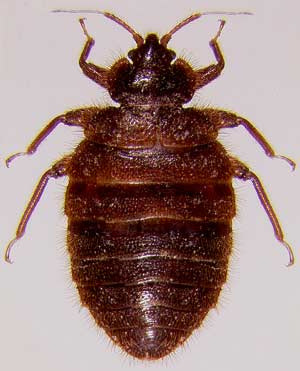
Appearance
Size
Bat bugs are around the same size as bed bugs.
They are slightly smaller than bed bugs with adult bat bugs growing up to 4mm rather than 5mm like bed bugs.
Color and Shape
Bat bugs look very similar to bed bugs. They have a flat, oval, and dark brown appearance.
They do tend to take on a brownish tint rather than the reddish tint that bed bugs take on.
Antenna and Legs
Similar to bed bugs, bat bugs have six legs and two antennae.
Bat bugs legs are slightly shorter than bed bugs legs, making them a bit d than common bed bugs.
Hair
Bat bugs are unique to bed bugs because they have fringe hairs located just below their heads and bodies.
Diet
Like bed bugs, they also feed on blood, with their preferred hosts being bats.
These bugs will instead not feed on human blood but will suck on it if food is scarce.
Bat bugs require bat blood to reproduce.
While they will attack humans and other mammals if bats migrate.
Fortunately, without bat blood, they can’t reproduce.
Habitat
Bat bugs live near and around where bats nest.
They tend to live inside caves, trees, attics, bridges, in crevices outdoors.
Just like bed bugs, they tend to live near their host.
This means that it’s rare to find bat bugs on mattresses and furniture.
With that being said, bed bugs will gravitate towards humans if they lose access to their host, bats.
This might happen it bats migrate, lose their habitat, or die.
If the bats were inside your home, bad bugs move towards where their human hosts frequently.
This is typically inside your bedroom on your mattress, box spring, and fabric folds similar to the common bed bug.
Distribution
Bats are versatile mammals that can adapt to nearly any environment.
There are bats species in all 50 states of the United States.
This means that bad bugs are found in all fifty states.
Bat bugs are far less common in harsh or extreme environments such as high heat and heavy snow.
While they are less common, they are not absent. In a proper environment with a reliable food source, bed bugs can survive in harsh weather.
Diseases
Bat bugs can transmit diseases, although it is unlikely.
For bat bugs to transmit disease, they must first feed on a bat that has a transmittable disease.
A study conducted on Thailand bat bugs found that they were able to transmit encephalitis virus to workers mining for bat guano.
This can pose a great danger to humans that come in contact with bat bugs.
It is important to note that not all bat viruses are transmittable to humans. Those that are transmittable are known as zoonotic viruses.
There are over 60 zoonotic diseases, but there is no research on which diseases can be transferred to humans.
Causes
The main cause of bat bugs is bats.
If you have bat bugs, there are likely bats nesting inside or outside your home.
If the bat bugs are moving inside your home, then it’s likely that the bats have either died or migrating, and some bat bugs were left without a host.
3. Swallow Bugs
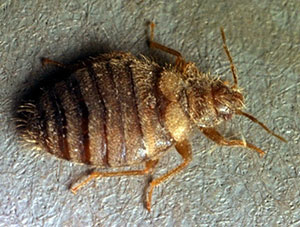
Appearance
Color
Swallow bugs are similar in color to common bed bugs. They take on a light brown to reddish-brown.
There is some exception that some swallow bugs can take on a grey tint that other species of bed bugs do not.
Shape and Size
Adult swallow bugs grow to around 3/16th of an inch or about 4-5mm.
They are similar in size to common bed bugs, so they are often confused for one another.
Antenna and Legs
Swallow bugs have two antenna and six legs, just like all other species of bed bugs.
There are unique in that the 3rd and 4th segments on their antenna are equal in length.
Most other species of bed bugs have segments that progressively get shorter.
Hair
Swallow begs typically have small hairs around their head and on their bodies similar to bat bugs.
It’s very difficult to see these hairs unless you look very closely, using a magnifying glass or a microscope.
Diet
Swallow bugs prefer to get their source of food from Cliff swallows.
They will also feed on other nearby birds or mammals near the nest of the cliff swallow.
They will also target humans if the cliff swallow migrates or dies off.
Swallow bugs will target other warm-blooded mammals when they lose their host.
Habitat
Swallow bugs are common anywhere there is a swallow bird.
Swallow bugs tend to live in the nest of the barn swallow.
Swallows build large nests that are full of mud, branches, and grass.
These nests give swallow bugs plants of crevices to hide in, and they can come out of the nest when necessary to feed on the swallows.
Despite their name, barn swallows don’t only build their nest inside barns.
They build their nest in any human-made structure, that is near open fields.
They tend to avoid cities and prefer more rural areas, which is why they are commonly found on barns or the eves of other outdoor structures.
Distribution
Region /Distribution
Swallow bugs are common wherever the swallow birds are nesting.
Unfortunately, swallow bugs are common in every U.S state.
Swallow birds prefer to live near open fields or rural areas.
As a result, they are common near structures near large open fields, which is why they are commonly found near barns and other outdoor structures.
Diseases
Swallow bugs can transmit diseases, although it’s not often.
A study found that swallow bugs were able to transmit diseases they contracted from birds.
The research on the transmission of diseases is limited and often only happens with the bird being infected with a transmittable disease to humans.
Even under the right conditions, only a limited number of bed bugs become carriers of the virus.
Causes
The main cause of swallow bugs is the swallow bird.
If you have swallow bugs in your home, it is likely that there was a swallow nest near your home.
If the swallows have migrated or you recently removed the nest, the swallow bugs will look begin looking for a host.
4. Poultry Bugs Or Mexican Chicken Bugs
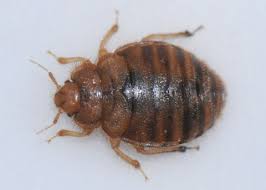
Appearance
Color
The Poultry bug is a cousin of the bed bug similar to swallow and bat bugs.
They look very similar to bed bugs in terms of color.
They often take on a light brown or reddish-brown color.
Shape and Size
Poultry bugs are oval, just like bed bugs. They are also comparable in size.
Poultry bugs are almost identical in terms of shape and size to the common bed bug.
Antenna and Legs
Both chimney bugs and bed bugs have segmented antennas.
They are different; however, in that bed bugs, antennas get shorter towards the tip.
Swallow bugs’ antennas, on the other hand, are uniform in size.
Hair
Poultry bugs have small hairs around their head and bodies similar to the bat bug and swallow bug.
Diet
Poultry bugs are blood-sucking insects.
Poultry bugs prefer to get their source of food from chickens or other domesticated fowl.
Domesticated fowl are commonly found on farms or ranches.
Habitat
Poultry bugs are common on farms or ranches.
These bed bugs will live near any domesticated fowl.
They are common in the living areas of domesticated fowl, including nesting and roaming areas.
These bugs pose a severe problem for farmers and ranchers.
Distribution
Poultry bugs are common wherever there are domesticated birds such as chickens, turkeys, rosters and among other birds such as eagles and hawks.
They are often found inside breeding facilities and farms where they pose a severe threat and problem for farmers.
There is no particular region they prefer but they are common in South America and Eastern, Midwestern, and Western U.S states.
Diseases
Poultry bugs prefer to feed on domesticated fowl.
Given a chance, they will feed on humans, although it’s unlikely.
Poultry bugs will typically only bite people if they are in a structure connected to a home.
It is also possible to get bitten by poultry bugs if you are in enclosures at night when activity is high.
Causes
The main cause of poultry bugs is domesticated fowl.
These bugs are attracted to breeding facilities and farms where these animals are abundant.
Poultry bugs can migrate indoors if enclosures share a wall with homes.
Also, if chickens and other birds roam freely indoors bed bugs can migrate indoors as well.
5. Chimney Swift Bugs
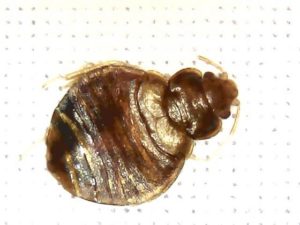
Appearance
Color
Nearly all bed bugs take on the same color. They often take on a light brown or reddish-brown color.
Chimney swift bugs tend to be on the darker side when compared to other bed bugs.
They look very similar to bed bugs in terms of color.
Shape and Size
Chimney bugs are oval, just like bed bugs. The one noticeable difference is that chimney bugs are smaller than bed bugs.
Antenna and Legs
Both chimney bugs and bed bugs have segmented antennas.
They are different; however, in that bed bugs, antennas get shorter towards the tip.
Chimney swift antennas, on the other hand, are uniform in size.
Hair
Chimney bugs typically have small hairs around their head and bodies.
Bed bugs do not have any hair.
Diet
Both bed bugs and chimney swift bugs are blood-sucking insects.
Chimney swift bugs prefer to get their source of food from chimney swifts, as the name suggests.
If the chimney swift dies or migrates these bugs will resort to other nearby birds nests or mammals.
If the nest is located inside structures, they will target humans, although it is unlikely.
Habitat
These bugs are found in the nest of the chimney swift bird.
These birds build their nest in chimneys, and other vertical surfaces such as air vents, wells, hollow trees, and caves.
You will find swift chimney bugs inside hiding inside or nearby the chimney swift birds nest.
Distribution
These birds forage over urban, suburban, rivers, lakes, forests, and fields.
Chimney swift birds are common across the East, Northeast, and Mid West U.S.
There are also some cases of chimney swifts in southern California during the summers.
Diseases
There has not been any research into the transmission of diseases of chimney swift bugs.
It is likely that like other bed bugs, it is rare and uncommon for them to transmit diseases to humans if they are bitten.
Causes
Similar to many other species of bed bugs, the main cause of the Chimney Swift bug is the chimney swift bird.
If you have a chimney swift bug it’s likely there is or was a nest inside your home.
Chimney swift bugs are common in the Eastern and Western U.S, Check for nest in any vertical surfaces such as chimneys or vents.
6. Tropical Bed Bugs
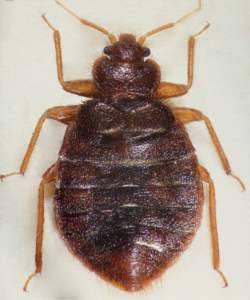
Appearance
Color
The tropical bed bugs are a relatively new and unstudied species of a bed bugs.
They are similar in color to traditional common bed bugs.
They take on a light brown or reddish-brown color.
Early reports from infestations suggest that adult tropical bed bugs are darker even before feeding.
Shape and Size
Tropical bed bugs are the same size and shape as a traditional common bed bug.
They do have a unique pronotum shape.
While it is typically hard to identify with the naked eye, the distinction is subtle but an evident difference between these species.
Antenna and Legs
The antenna and legs of the common bed bug and tropical bed bug are identical with no distinct differences.
Hair
Another difference between the common bed bug and the tropical bed bug is that they have hairs around their head and bodies.
Their hairs are much more sparse and straight that those found on other bed bugs such as the bat bug.
Diet
The diet of the tropical bed bug is relatively unknown but early research suggest that they prefer humans.
It is also possible that they will resort to pets and other mammals if a human is not available.
Habitat
Like comm bed bugs, tropical bed bugs are most commonly found in bedrooms.
In bedrooms, they hide inside small cracks and crevices on mattresses, box springs, bed frames, folds in fabric, and other furniture near where humans sleep.
Tropical Bed bugs prefer to live near their host.
They can also infest other areas that humans frequent such as couches, carpets, and other furniture.
In larger infestations, they can live behind baseboards, inside cracks on walls, picture frames, electronics, electrical switchplates, and behind wallpaper.
Distribution
Tropical bed bugs are common in more tropical and sub-tropical climates.
They are found in Asia, some South American countries, and other tropical islands.
In the U.S, they are only a few reported cases of states with tropical bed bugs.
The main state where these bugs are located is in Florida, but a few cases have been reported in Georgia and several other southern states.
Diseases
The research on the tropical bed bug’s ability to spread diseases is in the early stages.
Early reports of tropical bed bugs in the U.S suggest that they are very similar to the common bed bug.
This means that it is unlikely that they are able to transmit any diseases.
The main concern with tropical bed bugs similar to common bed bugs is that their bites are bothersome.
Their bites can cause anxiety and lack of sleep.
There is also the potential for skin infections due to excessive scratching.
Causes
The main reason for a tropical bed bug infestation is that they hitchhiked on someone or something from another home with an infestation.
They can enter your home by attaching themselves to backpacks, luggage, clothes, grocery bags, etc.
In most cases, bed bugs don’t invade your homes from an outdoors.
Bed bugs can also enter your home through used furniture, electronics, and clothing.
Frequently Asked Questions
What Type of Bed Bug Has a White Dot On Its Back?
If you have a bed bug with a white dot on its back then you don’t have a bed bug.
If this is the case you likely have a species of tick.
There are no species of bed bug with a white pot on the back.
What Baby Bed Bugs Look Like?
Baby bed bugs, or nymphs, go into five stages before becoming a full adult.
When bed bugs first hatch, they are only about 1.5 mm long. They have white, oval, and flat bodies.
The nymphs also have two antennas and six legs.
As they mature, they gradually turn from white to dark brown.
Nymphs shed their skins to grow in a process called molting. Everytime they molt they become slightly darker and bigger.
Baby bed bugs need to feed on blood to grow. If they can find enough food, they can become full adults in about six weeks.
They can grow up to 4.5mm long before shedding their exoskeleton one last time.
Adult bed bugs can grow up to 5mm long.
What Do Bed Bugs Bites Look Like?
When bed bugs bite you, they administer an anesthetic to make it painless. This method allows them to suck your blood without you noticing.
They also release anticoagulants so they can feed on your blood as efficiently as possible.
Once bed bugs finished feeding, they return to their harborage until they need to feed again.
But while bed bug bites are not painful at first, they can eventually become swollen and irritated.
Bed bug bites look like welts and do not have a red spot at the center, unlike other insect bites such as spiders and fleas.
Bed bugs will bite you anywhere there is exposed skin.
Common locations for bed bites include:
- Arms
- Legs
- Ankles
- Back
- Torso
- Neck
- Feet
How To Get Rid of Bed Bugs?
There are several different methods that you can use to eliminate bed bugs.
The one you choose will depend on the severity of your infestation and budget for treatment.
1. Vacuuming
Vacuuming is an excellent method for quickly removing many bed bugs, eggs, and skin shells.
Unfortunately, for larger infestations, it’s not always possible to target all bed bugs.
For this method to be effective, you need to target all the locations that bed bugs are hiding.
I recommend using crevice tools designed to help your reach bed bugs hiding in folds and crevices.
Its also best to use a vacuum with a HEPA filter.
Professional pest control companies prefer these filters because the filter will ensure that particles don’t become airborne once you start vacuuming.
This is important because bed bug skins and remains have many allergens that should be unhealthy and should not be inhaled.
2. Fumigation
Fumigation involves releasing insecticidal gas into a bed bug infested areas.
This method allows you to penetrate areas that are difficult to access, such as folds in fabrics, small crevices, and seams.
That said, fumigation requires extensive preparation.
You’ll need to vacate all living things in your home until all the fumigant traces have dissipated.
Fumigation of entire houses or entire rooms requires professional assistance, which can be costly.
Fumigating smaller items such as electronics or couches can be done at home using a large sealable bag and a DDPV strip.
3. Steam
Steam is an effective bed bug treatment that you can do yourself.
Bed bugs and their eggs will die at temperatures above 120 degrees Fahrenheit.
Most steamers can reach up to 240 degrees Fahrenheit, making them highly effective against bed bugs.
For effective steam treatments, every area with bed bugs needs to receive localized steam above 120 degrees.
Steam is also great because it kills bed bugs without using toxic chemicals from the insecticide.
When treating bed bugs with steam, all bed bugs need to be eliminated during the initial treatment since steam does not have a residual effect.
4. Heat
Extreme heat is fatal to bed bugs.
Heat treatments increase the heat in structures, rooms, and items to a temperature lethal to bed bugs and eggs.
Using heat treatments in larger structures requires specialized equipment and professional assistance.
Hiring a pest control company to do heat treatments around your house is highly effective, but it can be costly.
On average, heat treatments can cost anywhere from several hundred dollars to several thousand dollars.
The most effective way to remove bed bugs from smaller items such as books, laundry, bags, etc., is using a heat chamber.
Heat chambers allow you to place small items and seal them inside while the heat is on.
To kill bed bugs in all life stages, temperatures must reach above 122 degrees Fahrenheit.
5. Mattress Encasements
Mattress and box spring encasements can be a great way to control bed bugs.
Encasements create a barrier between you and the bed bugs living in your mattress.
They are great if you are looking for an inexpensive and quick solution for your bed bugs.
The idea behind mattress encasement is to starve bed bugs.
6. Insecticide
Insecticide treatments involve spraying chemicals on or around bed bugs.
When using insecticides, make sure to read and follow all label instructions.
Pay special attention to what type of furniture, surfaces, and materials is the insecticide safe to use.
You’ll also want to pay attention to how long it takes before re-application and follow accordingly.
Where do Bed Bugs Commonly Hide?
Bed bugs and its other relatives try to live close to their host.
They also look for shelters with little air movement and plenty of cracks and crevices.
Some common places bed bugs aggregate are:
- Mattress
- Bed Frame
- Boxspring
- Clothes
- Nightstand
- Dresser
- Head Board
- Couch
- Electronics
- Carpet
- Luggage
- Blinds
- Curtains
- Cracks, crevices, fabric seams, and folds
What Are The Signs Of Bed Bugs?
Some of the most common signs of bed bug infestation are:
- Live bed bugs – Bed bugs are about the size of a grain of rice, oval, flat, and light brown to reddish-brown.
- Bed Bug Eggs – Bed bugs are smaller than a grain of rice, white and are oval.
- Dried blood – Small specs of fresh blood will look like dark red dots around your couch.
- Skin casings – Bed bugs shed their skin to grow. The presence of these skin cases is a good sign of bed bug infestation.
- Bed Bug Feces – bed bug feces appears as small black spots or black/brown streaks.
